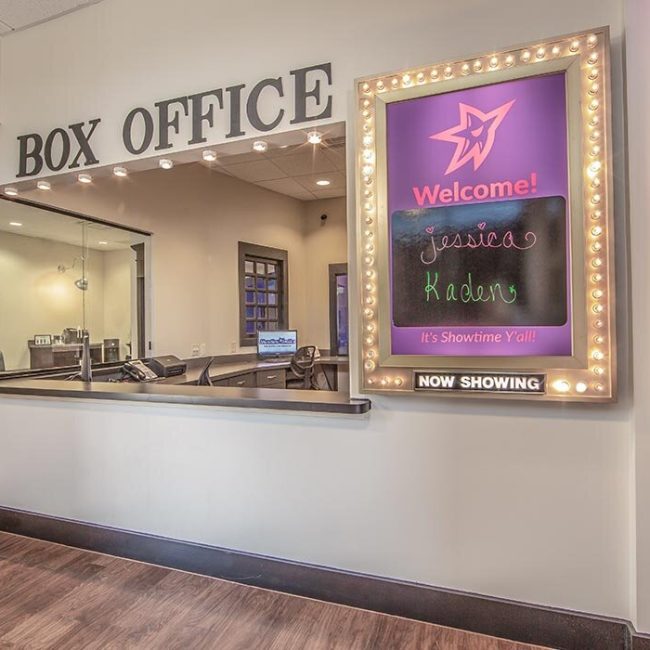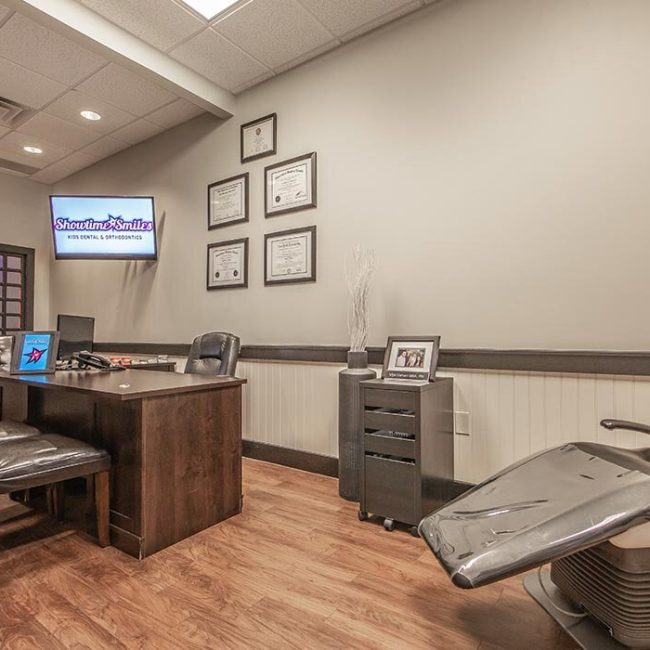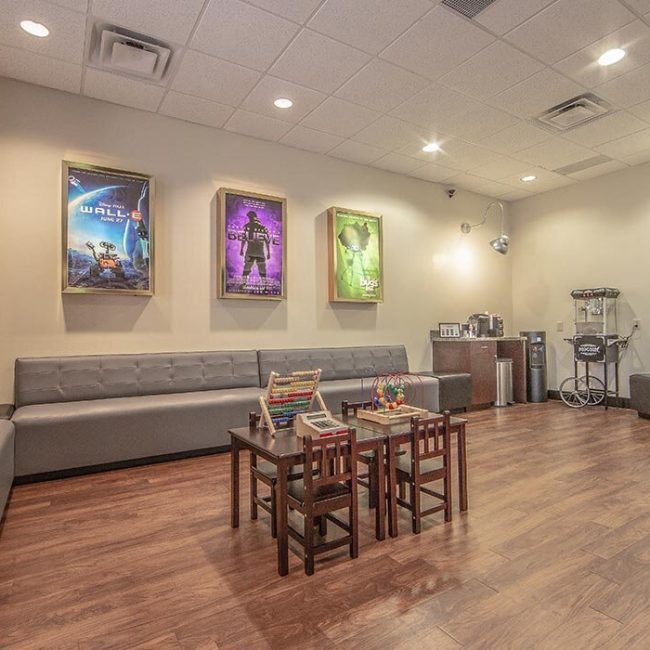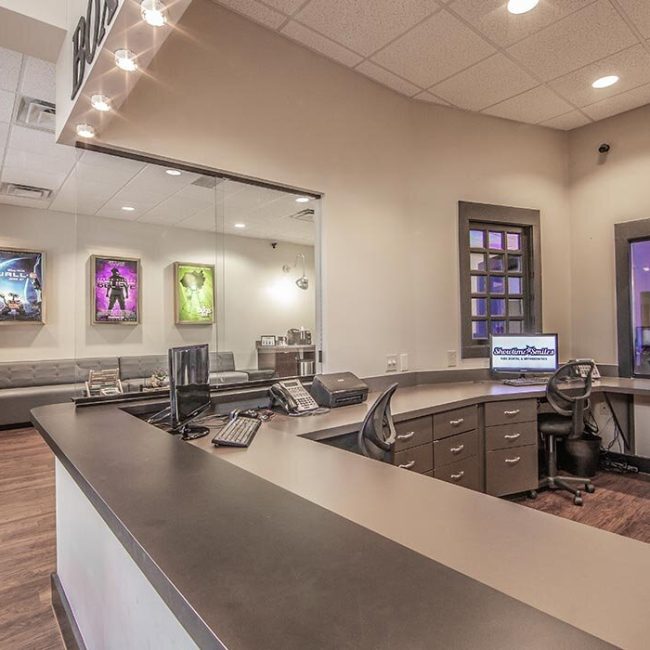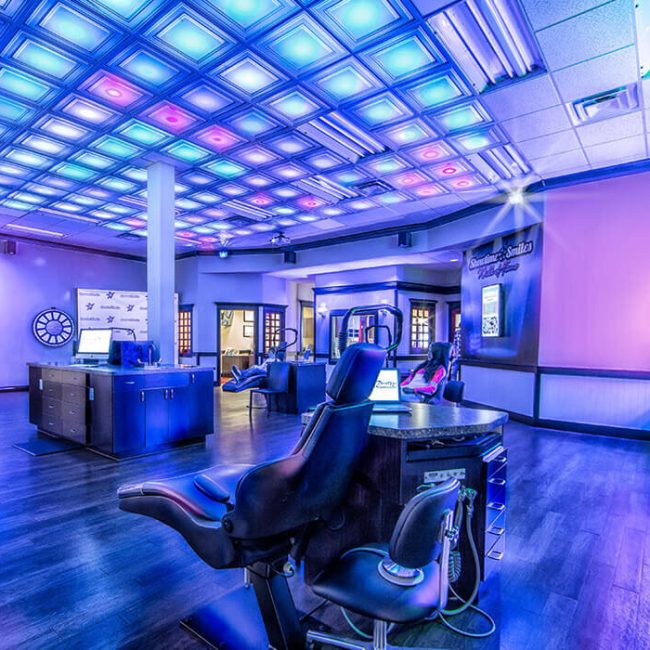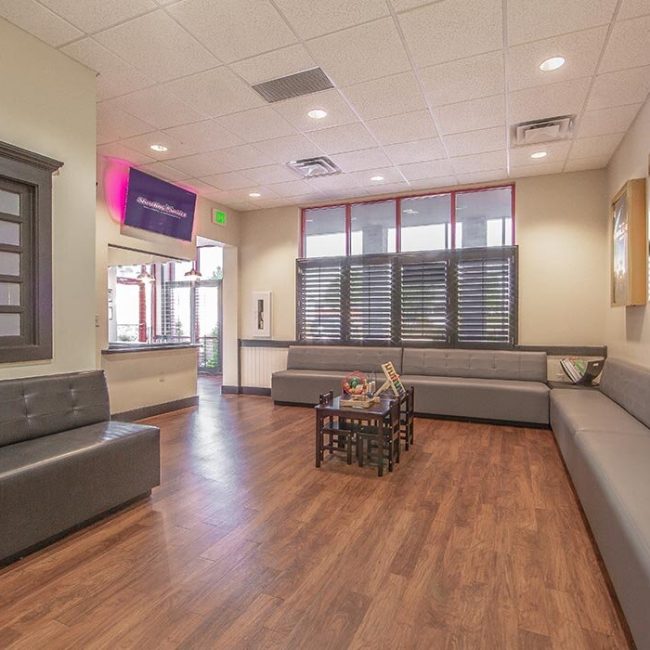How Can An Orthodontist Help Me?
Orthodontists normally deal with the process of aligning teeth. They can give x-rays to check the alignment of the jaw and teeth. Depending on the office, they are trained in administering different methods of straightening teeth, such as Invisalign, clear and ceramic braces, or traditional braces.
It can be confusing trying to differentiate between all the different types of dentists, so today we’re breaking down exactly what an orthodontist does and how their specialty is different from the other doctors. Next time you need to see an expert, you’ll know exactly where to go!

Orthodontists are dentists who specialize in realigning the teeth and jaws. To make it simple, just look at the anatomy of the word. “Ortho” means to straight or upright, “odont” means relating to the teeth, and “ist” means a follower of a practice. Therefore, orthodontist means someone who practices straightening teeth.
Although orthodontists are also educated in general dental care, they are trained in a specific subset of skills relating to aligning the teeth. Orthodontists in the US have to complete 4 years of undergraduate school, 4 years of dental school, and 2 years in a postdoctoral program for orthodontics. While they can clean your teeth, diagnose oral diseases, and treat general oral problems, that’s not what they’re trained to do.
If you need a dental cleaning, a general exam, or fillings for cavities, it’s recommended to make an appointment with a general dentist. They will have the equipment and experience necessary to treat your teeth because that is what they do on a daily basis. Orthodontists, on the other hand, may not have the tools or experience needed at the moment because they don’t practice general dentistry regularly.
Orthodontists normally deal with the process of aligning teeth. They can give x-rays to check the alignment of the jaw and teeth. Depending on the office, they are trained in administering different methods of straightening teeth, such as Invisalign, Damon braces, or traditional braces.
After four years of dental school, pediatric dentists participate in a two year program where they learn about dentistry for infants, children, and teens. Oral care for children differs from adults because it primarily deals with the intricacies of developing teeth and jaws. If you have a young one, it’s recommended to go to a pediatric dentist over a dentist because they have the communication skills and tools to work with little kids.
If you’re interested in an early orthodontic screening for your child, you can usually ask either an orthodontist or a pediatric dentist. They both have the x-ray equipment and background knowledge needed to determine whether your child will need two-phase treatment. We recommend seeing both, so you can get a second professional opinion and make your decision from there.
An oral surgeon is quite similar to an orthodontist because they both study the use of anesthetics and jaw development. Unlike an orthodontist who works to align the mouth and jaw properly, an oral surgeon studies emergency medicine, plastic surgery, and the anatomy of the ears, nose, throat, muscles, and skin surrounding the mouth region.
If you’re wondering when to visit an oral surgeon, the answer is you might never have to. Oral surgeons can perform restorative surgery to facial trauma, neck problems, or jaw damage. They also have the capability to perform cosmetic surgery for aesthetic reasons. Patients with severely obstructive sleep apnea can also see an oral surgeon for help with the referral of their dentist.
In the event of an orthodontic emergency, patients should go to their orthodontist because the doctor already has an intimate knowledge of the patient’s orthodontic treatment and condition. However, there may be extreme cases where surgery is need to correct a problem, like a dislocated jaw or fractured bone. In that case, the patient will have to see an oral surgeon.
Prosthodontists perform many cosmetic procedures, but they cannot realign teeth with braces like orthodontists can. They specialize in creating artificial replacements for the mouth. If you’re interested in getting dental bridges, caps, veneers, or implants, a prosthodontist can help you.
Many general dentists also study prosthodontics and provide the same services. If you’re interested in improving your smile without getting braces, ask your dentist if they also offer prosthodontic cosmetic options.
If you have an more severe teeth problems like hyperdontia (having too many teeth), underbites, crossbites, overbites, or gaps, you’ll want to make an appointment with your orthodontist.
Pathology is the study of the cause and effect of diseases and an oral pathologist examines diseases relating to the mouth. If you have a suspicious growth or condition around your orofacial area, your orthodontist may refer you to an oral pathologist. There, the oral pathologist will attempt to diagnose whether you have an oral disease and what it is. This can be done by swabbing the mouth or taking a sample of tissue. Oral diseases include oral cancer, herpes, fungal infections, and more.
Should you notice something unusual growing around or in your mouth, ask your dentist about it before going to an oral pathologist. While your orthodontist may be able to guess what’s wrong with the affected area as they’re working on your braces, they might not be able to see or treat it, so schedule an appointment for your general dentist if you’re concerned. Your dentist can tell you need to be tested by an oral pathologist. Prevention is key to oral health and it’s better to be safe than sorry!
All dentists, regardless of what they specialize in, are trained to a certain degree about endodontics, which is the study of the inside of the tooth. Endodontists are dentists who work extensively to treat problems with the dental pulp, which is in the very center of the tooth. Your dentist may refer you to an endodontist if you need a complicated root canal surgery. Worry not, root canals may be scary, but endodontists are trained to make them as quick, painless, and successful as possible.
The dental pulp is made of soft tissue, performs sensory functions, produces dentin, and provides nutrients to the rest of the tooth. It is a central part of the tooth, so it’s important that it’s well maintained. Before an orthodontist can recommend a braces treatment to a patient, it’s vital that the patient has strong teeth and healthy dental pulp. A dental professional would never recommend moving teeth if the roots are infected or weak. Luckily, endodontists can treat these problems before you visit an orthodontist.
There you have it; these are the most popular types of dentists and when you should visit them. At Showtime Smiles Orthodontics, our orthodontist also practices pediatric dentistry, so you can save time by visiting one office for two services. Dr. Dan is an expert at diagnosing and treating children’s teeth, but he also has years of experience performing orthodontics. If your child needs another type of dental specialist, feel free to call our dental office in McKinney – we can give you more information and give you a list of other dental specialists.

Why Should I See An Orthodontist?
Crooked teeth may seem like a minor inconvenience now, but they could result in serious health issues later down the line.
Although getting braces or invisalign is about improving the smile and appearance, there are also a lot of health reasons why you should see an orthodontist. A comprehensive orthodontic treatment includes aligning the teeth, orofacial muscles, and skeleton, so they can work together in a healthy, functional system. At Showtime Smiles Orthodontics, we consider our patient’s health and long term wellbeing first when we recommend any orthodontic procedure.
Crooked teeth may seem like a minor inconvenience now, but they could result in serious health issues later down the line. The best way to know for sure is by seeing a professional orthodontist, so they can identify any present or developing problems. We recommend going to get checked up by an orthodontist if you or your child have any of the following concerns:
What is a misaligned jaw? Well, it’s exactly what it sounds like – if the upper and lower teeth do not meet properly when you bite down, it is often because the jaw is misaligned. Many, if not most, people have a mild to severe overbite, underbite, or crossbite. In some cases, a misaligned jaw is harmless. However, it can also cause a whole host of problems, such as headaches, ear pain, breathing problems, excessive wear of teeth, and difficulty chewing.
The orthodontist will be able to get a closer look at the way the teeth and jaws are aligned with advanced technology, such as x-rays and intraoral photography. This will give the orthodontist an in-depth understanding of your bone structure that can’t be seen with the naked eye.
A gap-toothed smile can be adorable, even considered high fashion nowadays! Even though we’re all about keeping up with the latest trends at Showtime Smiles Orthodontics, having multiple gapped teeth can be difficult to clean and maintain at times. Food can easily get stuck between gaps, creating opportunities for plaque and dental decay. Spaced teeth are can be caused by genetics, thumb sucking, tongue thrusting, or even periodontal disease.
Most of the time, diastema can be fixed with orthodontic treatment by gradually tightening the teeth until there is no space left. If the teeth are too small, dental veneers may need to be placed over the gaps after the braces. The orthodontist can give you a better understanding of your treatment options.
The temporomandibular joint connects the jaw to the temporal bone and allows the mouth to open and close smoothly. Pain in this area could be attributed to arthritis, trauma, mouth clenching, or an incorrect bite. TMD or temporomandibular joint disorder is often characterized by:
Clicking or popping noise when opening or closing the mouth
Headaches or pain near the temporal area and ears
Soreness in the jaw after eating or speaking
Locking of the joint or difficulty opening the mouth
This problem can actually be fixed with orthodontic treatment. If the joint is in the wrong place, it can often be corrected by realigning the jaw where it’s supposed to be with braces.
Grinding teeth, also known as bruxism, can be a huge problem if left untreated. Frequent and severe bruxism can lead to headaches, damaged, teeth, jaw disorders, and other disorders. While there’s no definitive cause of bruxism, many blame it on sleep apnea, stress, or an abnormal bite. When teeth aren’t aligned correctly, it can prompt teeth grinding. The best way to treat bruxism is by visiting an orthodontist or dental professional. They can recommend a mouth guard, sleep mask, or orthodontic treatment to circumvent grinding in the future.
When teeth are not in the right position, they can get crowded, leaving little space for other teeth to grow out. Impacted teeth are often caused by crooked teeth and they can lead to problems like gum disease or infection because they’re difficult to clean.
This can be easily prevented by early interceptive orthodontic treatment for children who are still losing their baby teeth. By aligning the jaw and facial structure before the adult teeth grow in, this treatment ensures that there is enough space in the mouth for the permanent teeth to develop correctly.
For our patients who have passed the stage for early interceptive treatment, braces can still help! Repositioning the teeth can give the dentist enough space to remove the impacted tooth without affecting other parts of the jaw and teeth. Orthodontics also fill the gap left by the impacted tooth.
Many people that experience breathing difficulties during the day or at night may benefit from orthodontic treatment. Expanding the palate and correcting the bite will open the airway, allowing for easier breathing through the mouth. A misaligned jaw could also be affecting the air passageway. If the jaw is pushing against the joints, it could make opening the mouth to breathe difficult, especially when lying down.
Having trouble communicating? Braces can fix that! Often, people who have speech impediments have gapped teeth, open bites, or malocclusions that are easy to fix with braces. An open bite is when the teeth don’t meet when the mouth is closed and malocclusion is a fancy word for misaligned jaw (see above). This could affect a person’s ability to pronounce certain letters. Though it may be difficult to pinpoint the exact reason behind a speech impediment, the orthodontist will be able to tell you whether braces could benefit from braces.
Severely crooked teeth could actually affect your ability to brush your teeth! Like taking a picture, the right angle and position are critical for getting your smile camera-ready. When teeth overlap and crowd each other, it’s hard to reach every nook and cranny when you brush and floss. Plaque builds up much more easily. If you find yourself getting cavities and toothaches all the time, you may want to make an appointment with the orthodontist.
It’s also important to note that once you get braces, it’s even more important to keep up a thorough oral health routine. Brackets or Invisalign can trap food debris, allowing bacteria to damage teeth. While you have them on, you may need to brush, rinse, and floss more than twice a day. However, the results will make your life a lot easier.
If you or your child participate in contact sports like football or basketball, there’s a high chance of facial injury and trauma. When the jaw is improperly positioned, this could put you or your child at a higher risk of damage. To avoid these problems, we recommend asking the orthodontist about how malocclusions or jaw misalignment could affect performance in sports. There are also tons of mouthguards for people with or without braces to protect their teeth when playing sports. To learn more, check out our orthodontic guide about proper protection and equipment for sports.
Lack of confidence from your teeth can lead to a negative body issues and even mental health disorders. Though self esteem shouldn’t be solely based on appearance, having crooked teeth or a speech impediment can be difficult to deal with, especially in our day and age. At Showtime Smiles Orthodontics, we want all our patients to be comfortable and confident when they smile!
We’re stuck with our smiles for the rest of our lives, so we deserve to be happy with them! Our mouths and teeth serve important purposes such as talking, eating, singing, breathing, and more, which is why we should take care of them. At Showtime Smiles Orthodontics, our orthodontist can determine if there are any underlying structural problems and correct them with braces or Invisalign. If you’re worried about what to expect at the orthodontist, feel free to give us a call with any questions you have. We’re here to help!
Which Orthodontist Should I Choose?
Choosing the right orthodontist for your or your child’s braces hinges on a handful of factors.
Finding the right orthodontist is like wandering through a maze full of dead ends. Everything looks the same. Even though scouring the web seems like a fruitless task, taking the time to choose the best orthodontist for you can be well worth the wait.
Not every orthodontist is the same! Some doctors offer different treatments than others do. Before you spend precious time visiting different offices, establish your priorities. Invisalign, office hours, TMJ treatment? Of course, with all the options available, it can be difficult to know exactly what you want. Here are three fundamental questions to answer before you find the one.
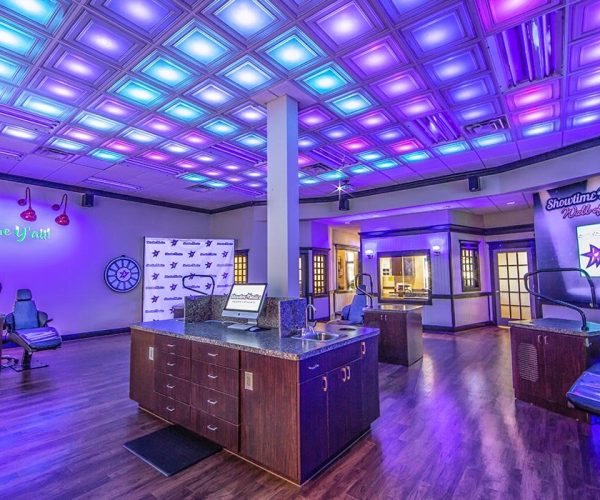
First things first, who do you need an orthodontist for? Is it for yourself or a loved one? Many orthodontists specialize in adult, teen, kids’ braces, or all three! Here’s what you can expect from these orthodontic specialists:
Orthodontists for Kids
Children can get braces as early as 7 years old. Orthodontists use a two-phase treatment system to correct jaw development problems for kids. The first set of braces is used for kids with baby teeth to correct any jaw problems. After all the adult teeth grow in, orthodontists can place the second set of braces to make sure the adult teeth are straight.
If you are worried about your child’s jaw development, pediatric dentists who specialize in infants, kids, and teens are also a great place to start. Both orthodontists and pediatric dentists can give your child an early orthodontic screening as their adult teeth are growing in.
At Showtime Smiles Orthodontics, we will be able to check for any abnormal bone growth and emerging teeth at an early orthodontic screening. From there, we can diagnose whether the child needs braces earlier on or not.
Orthodontists for Adults and Teens
Orthodontic treatments for adults and teens are similar but not quite the same. Adults may need special attention for issues such as bone loss or mild gingivitis, especially if they are older. It’s important for the doctor to monitor adult patients closely to ensure the braces do not exert to much pressure on the teeth at a time. This can lead to root resorption, a rare condition where the loss of dentine and cementum makes the tooth fall out.
Since teens are still growing, it can be easier to realign their teeth and jaw bones. They also have healthier teeth and bones, so there is less risk of dental complication throughout the orthodontic procedure for teenagers. There are tons of options for teens and adults alike, including Invisalign, traditional braces, lingual braces, and clear and ceramic braces. Ask the orthodontist about what types of braces are offered at their practice.
One decision many people struggle with is whether to choose Invisalign or braces. Here is a quick comparison between the two:
Invisalign
Invisalign is a removable, clear aligner tray used to straighten teeth
Invisalign retainers are typically replaced every 2 weeks; Showtime patients receive a 12 week supply of aligners
Invisalign is custom-made to fit your mouth, so it looks very natural
Invisalign can be more comfortable and safe than regular braces because there are no sharp wires or brackets
Invisalign must be removed for eating and cleaning which may be inconvenient for forgetful patients
It’s easy to clean teeth with Invisalign
Invisalign can take from 6 – 12 months to show results
Braces
Traditional braces are made of metal wires and brackets that are bonded to the teeth for teeth realignment
Braces are tightened every 8 – 10 weeks
There is no need to remove braces when eating
It can be difficult to clean teeth with braces
Braces are better for treating severe orthodontic problems such as extreme overbites, underbites, gaps, etc.
Braces typically take 1 – 3 years to take effect, depending on the severity of the situation
Both traditional braces and Invisalign require the use of retainers afterward.
Ultimately, there is no right choice. It just depends what is important to you. Once you pick what treatment you want, you can start looking up dentists who specialize in it. From there, you can choose the best orthodontist for you.
The most daunting part of going to the orthodontist is paying for the orthodontist. How much does the orthodontist cost anyway?
Orthodontists typically charge around the same price range, depending on the location. For example, getting braces in the heart of Dallas might cost you an arm and a leg compared to getting braces in McKinney. It’s also important to know that the cost of braces is unique to your situation. Call ahead of time to see what payment options the office provides. Here’s what you can ask about:
Credit cards
Debit cards
Dental insurance
Payment plans
CareCredit
Getting braces or Invisalign can be costly, so make sure the orthodontist you choose is ready to take your preferred payment, create a payment plan, or accept your insurance.
The Search
Now that you know what you’re looking for, don’t waste your time going to random orthodontists before doing your research.
Instead, ask around for referrals or look at online reviews when comparing them. Once you’ve narrowed down a few that offer the orthodontic options you’re interested in, call the office to ask a few questions. An oft overlooked aspect of visiting the orthodontist is how well you get along with the dental staff. Having a positive relationship with front desk workers can significantly improve your experience and speed up any paperwork that needs processing.
Once you’ve picked your top contenders, stop by for an office tour or if they offer it, a free consultation. There, you’ll be able to gauge if you like the office environment and whether the orthodontist is a good fit.
Here are a couple things to look out for when you’re on the search:
Board-certification
Make sure the orthodontist is board-certified. The orthodontist might have a degree and certification hung up on the wall, but you can always double-check online with the American Association of Orthodontists’ directory of board-certified orthodontists. This ensures that your doctor knows what he or she is doing and has the experience to properly operate.
In-depth explanation
Ask the orthodontist to explain the treatment process(es) in-depth. Make sure you clearly understand how long it will take, how much it will cost, and what steps need to be taken. Not every orthodontist will recommend the same treatment, so choose someone who gives you legitimate reasons for their treatment choice.
Office hours
Check if the office’s hours are compatible with your schedule. It’ll be a hassle to take off time just to get your braces tightened up to pick up new Invisalign trays, especially since you have to get it done every 2 – 4 weeks.
Cleanliness
See if the office, tools, and procedures used are clean and sanitary. This is a no-brainer, but you don’t want any risk of infection. Besides cleanliness, see if you like the general atmosphere of the office. Is it friendly? Are there toys or magazines to occupy you and your family in the waiting room? For example, we always show movies and provide entertainment for kids at Showtime Smiles Orthodontics & Pediatric Dentistry.
Contracts
Read contracts thoroughly before signing anything. You definitely don’t want to be getting stuck is some insane payment plan or legal dispute in the middle of getting your braces.
Finding the right orthodontist is no easy task, but it is one that pays off once you have the smile of your dreams. After all, braces don’t just serve superficial purposes; they’re often necessary for healthy jaw growth and day-to-day health.
If you have any questions about the orthodontic process, please refer to Showtime Smile’s Orthodontic FAQ. Our McKinney orthodontist, Dr. Dan, tries to provide as much information and as many resources to the public as possible. Patients should be well-informed about the health of their teeth. Feel free to contact Showtime Smiles Orthodontics today to book an appointment with our orthodontist to learn more about your options for yourself or a loved one today.
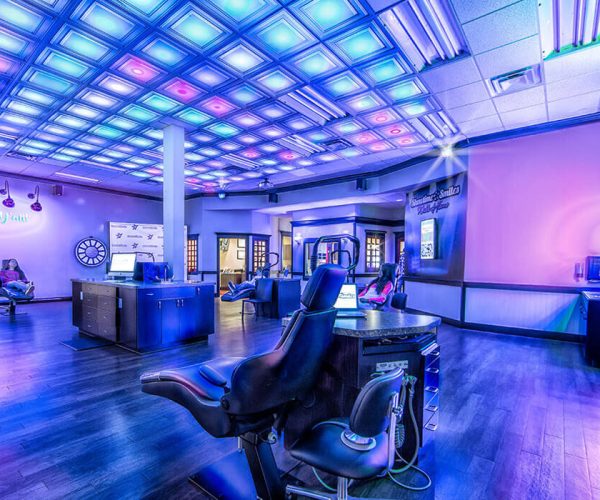
What To Expect At The Orthodontist
Here are answers to common questions our patients at Showtime Smiles have at each stage of the orthodontic process
Going to the orthodontist can be a nerve-wracking experience if you don’t know what’s going on. If you’re getting braces or Invisalign for the first time, there are a few steps to getting your braces fitted. Afterward, you’ll visit the orthodontist fairly regularly even after the initial appointment. As time goes on, most patients become more comfortable with the routine checkups.
Here are answers to common questions our patients at Showtime Smiles Orthodontics have at each stage of the orthodontic process:
The orthodontist will bond brackets to your teeth using a type of dental glue or cement. Then, the dentist will place the wires against the brackets and secure them using ligatures.
Ligatures are elastics that go around the bracket and hold the wires in place. They’re usually the brightly colored pieces that you see on the braces.
After that, the dentist will professionally dry your teeth to make sure everything is intact.
The procedure is usually 1-2 hours. It can be longer or shorter depending on your situation. If you have a lot of overlapping teeth, it can be difficult for the dentist to affix every bracket quickly.
Your orthodontist can change out your wires around every two weeks, so they can tighten the braces little by little to push your teeth into the right position. The process is done over the course of many months to allow the teeth and jaw to progressively straighten out.
Orthodontist can’t realign your teeth immediately because placing too much pressure on the teeth at once could damage them and hurt you. With a little patience, however, you’ll see incredible results before you know it.
It’s completely normal to experience a little pain or discomfort when you first get your braces. If you feel wires or brackets poking at you, ask your orthodontist if they can adjust the wires to make the braces more comfortable. Orthodontist can trim the wires and shape them differently to accommodate your needs.
As odd as it seems, many people use dental wax to ease any discomfort. The wax comes in small sheets that are shaped, so you can tear off small strips at a time. You can then tear off a small piece and mold it to your bracket to make a protective layer between your mouth and any sharp objects.
Braces can be annoying, but they shouldn’t be excruciatingly painful. If you find yourself severely irritated by your braces or in a dental emergency, let your orthodontist know and they can fix the problem. You don’t want to scar or bruise the inside of your mouth from your braces.
Emergency situations include:
Infection: Swelling, cysts, bleeding, and extreme pain may indicate an infection in the gums, mouth, or tongue that needs to be treated by a dental professional. The dentist or orthodontist can diagnose the problem and prescribe any antibiotics or painkillers as needed.
Trauma or injury: Getting injured with braces on can be particularly painful because the metal wires and brackets can rub against your mouth. If the wires are undone, a bracket comes off, or a teeth is damaged, visit an orthodontist immediately.
At the orthodontist’s office, there will be all the necessary equipment and staff to care for you. In the event that the dentist or orthodontist is unavailable, patients can also go to
When the orthodontist needs to fix your bite by realigning your jaw, they can use interarch elastics to push things in place. The elastics are stretched on a top bracket to a bottom bracket. Unfortunately, they do restrict jaw movement, so they to be taken out when you need to eat or brush.
Your orthodontist will show you how to put elastics back in. For sanitary reasons, you should be using new elastics every time you take them out. These little rubber bands are inexpensive and your orthodontist can supply you with a bag of them, but you can also purchase your own.
They’re sold online and in most retail stores. Just check out the dental hygiene section. The best part is you can also choose the color of elastics you want.
Most people see results after 1-2 years. The period it takes to straighten your teeth may take shorter or longer depending on your situation. For example, if you have an overbite, it might an extra month or so to realign the top and bottom teeth with elastics.
Though it can be frustrating to have braces, know that they will pay off!
People usually don’t notice how much their teeth have shifted until they get their braces off. You will probably see some noticeable differences in 6 months. Gaps will be closed, overlapping teeth will be separated, and crooked teeth will be straightened. It’s amazing!
Don’t be discouraged if you don’t see any differences early on. It’s hard to know how your teeth are doing when they’re covered in metal brackets and wires.
The orthodontist will take your braces off by first removing the wire and then taking off the brackets. After that, they will remove the cement used to bond the brackets to the teeth off. Afterward, the orthodontist will professionally clean your teeth to make sure there’s no glue left.
It’s important to take good care of your teeth with proper dental hygiene throughout the duration you have braces. Teeth are more susceptible to teeth decay, yellowing, and calcification when you have braces, so make sure to brush and floss regularly.
Retainers maintain your smile after your braces straighten out your teeth. Teeth can shift even after you get braces, undoing all the time and effort that your orthodontist put into your braces. Your teeth and mouth are constantly growing with your body, so it’s natural that they may move without the support of braces holding them in place.
Right after you get your braces off, the orthodontist will give you retainers to wear at all times, except when you eat and brush your teeth. Typically, you’ll wear these retainers six months to an entire year. After your bite stabilizes, you will only need to wear the retainers at night.
Your orthodontist will decide which type of retainers is best for your teeth. The three main types of retainers are:
Hawley retainers: These are the traditional retainers that most people use. They are made of plastic and custom-made to fit your mouth. There is a thin metal wire band that goes around your teeth to keep them in their position.
Essix retainers: The Essix retainers are a clear, plastic mold of your teeth that look a lot like Invisalign. They work just like traditional retainers, you keep them on unless you’re eating or brushing and flossing.
Permanent retainers: A bonded or permanent retainer is a metal wire attached to the back of the teeth with dental composite material. It can’t be seen because it’s behind the teeth and it ensures the retainers will be worn 24/7 to keep the teeth in place. It can, however, be a little difficult to floss.
After your braces are off and you have your first set of retainers, it’s imperative to keep them on as much as possible to maintain your teeth alignment. Retainers also require special care to keep them hygienic and effective. Be sure to brush them daily and soak them in cleaning solution.

Itero Scanner
At Showtime Smiles, we’ll make a great first impression! With our iTero digital scanner, we’ve eliminated the need for messy, goopy, putty-like traditional dental impressions.
Our iTero scanner uses a wand to digitally capture what we need to know with a quick and comfortable scan of the mouth. Our doctor will wave the magic wand for just a few minutes in your mouth and get everything we need to build your custom treatment plan!
We use these 3D images to create a model of your teeth and gums. From there, he will design an orthodontic treatment plan that’s completely customized to each patient’s individual needs. Pretty cool, huh?!
Yep! The digital impressions are highly accurate, more so than the putty-like impressions of the past. And the BEST part– you’ll be able to view a treatment outcome simulation on the screen so you can see what your teeth will look like at the end of treatment! You don’t have to imagine what they will look like when you can see for yourself.
You bet! The iTero scanner is completely safe. It emits no radiation and simply uses digital software to create the 3D image of your teeth and gums.

Meet Our
Doctor
When you’re at Showtime Smiles, you’re under the care of the best orthodontic team in the McKinney area. Our board certified orthodontist, Dr. Bar, has a certification granted by the American Board of Orthodontics. The distinction comes with years of extra residency, additional education and more hands-on patient care. When you choose a board certified orthodontist, you know that you are choosing someone that the dental industry deems the top of the class!

Our Office
- Tues-Fri: 8AM - 5PM
Hours are subject to change without notice.
Please call the office before coming in

